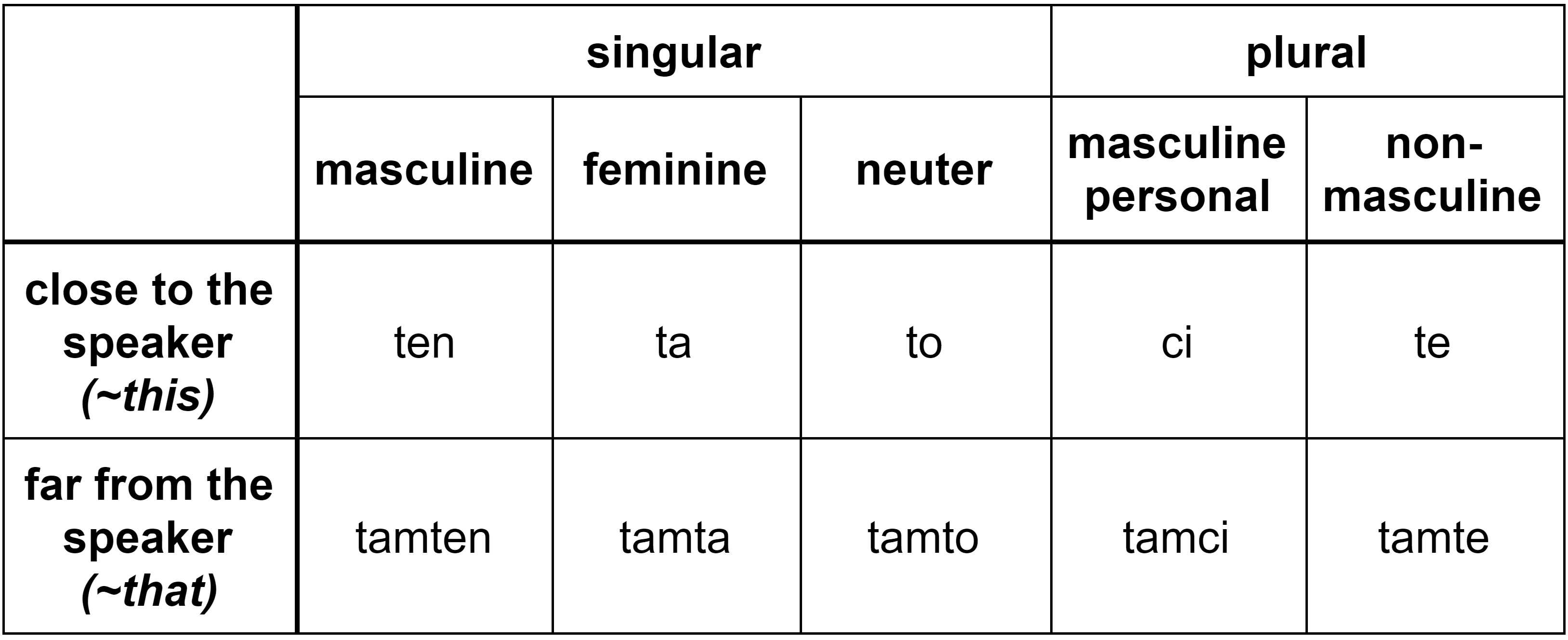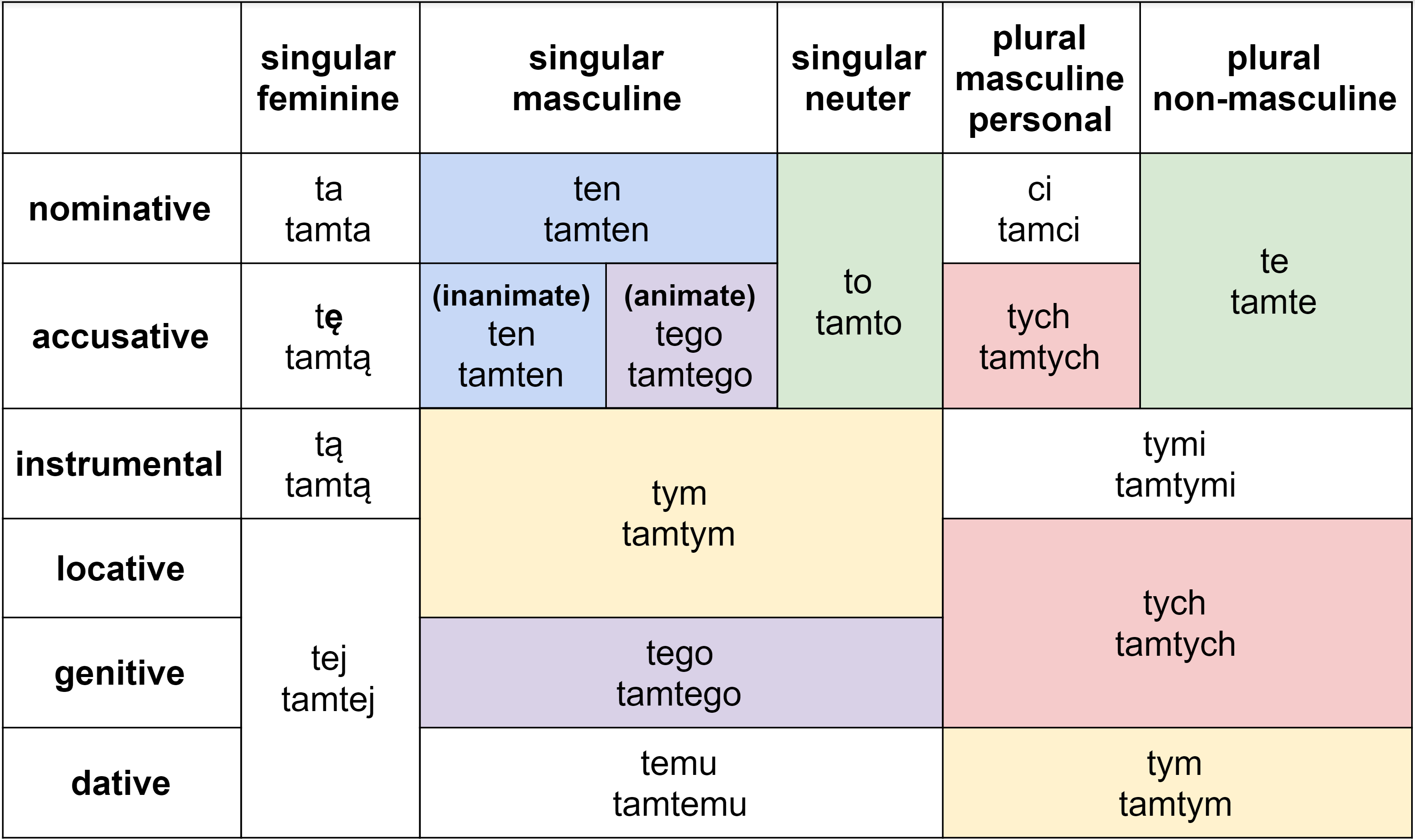Demonstrative pronouns are used to point at things, usually in order to distinguish them from other things. In English, the basic demonstrative pronouns are this, that, those and these.
In Polish, there are two types of pronouns. The so-called proximal demonstrative pronoun ten is used to point to things which are close to the speaker. On the other hand, the purpose of the distal demonstrative pronoun tamten is pointing at things that are further away.
If you wanted to say “this dog doesn’t bite” while pointing to a nearby dog, you would use the proximal pronoun ten and say “ten pies nie gryzie”.
Then, you could point to another dog that is running around at some distance and say “but that one does”, using the distal pronoun tamten: “ale tamten gryzie”.
Based on the example above, the distinction might seem to boil down to “ten = this, tamten = that”, but it’s not always that simple. This is mainly because the English pronoun that is used in many diverse ways, which often have nothing to do with pointing to remote things.
Thus, the simplest way express the difference between ten and tamten would probably be:
ten = the one here
tamten = the other one / the one over there
(By the way, this is reflected in the very structure of the word tamten: it is actually the demonstrative pronoun ten combined with the word tam, which means “there / over there”.)
Of course, demonstrative pronouns aren’t just used to express literal physical distance. You could say “podoba mi się ten pomysł” (“I like this idea”) to refer to the idea you have just heard about from your friend, or “kupiłem tamten samochód” (“I bought that car”) to make it clear that you are talking about a car you mentioned some time ago.
Number and gender of Polish demonstrative pronouns
Just like adjectives and some other pronouns, demonstrative pronouns have different forms for each grammatical number, gender, and case. Let’s start with number and gender, and we’ll get to case later.
The general rule is quite simple. You should always use a pronoun in the same number and gender as the noun that follows it:
Kim jest ta dziewczyna? (“Who is this girl?”)
Ten rząd jest skorumpowany. (“This government is corrupt.”)
Czy tamto okno się otwiera? (“Does that window open?”)
Tamte domy są duże. (“Those houses are big.”)
In each of the sentences above, the form of the demonstrative pronoun is governed by the noun that comes after it. Dziewczyna is a singular feminine noun, so it requires the singular feminine pronoun ta. Rząd is a singular masculine noun, so it must be preceded by the singular masculine form ten, and so on.
Both ten and tamten have five basic (nominative) forms, covering all possible numbers and genders:

It is easy to see that the tamten forms are just the ten forms with the prefix tam added, which makes them much simpler to memorize.
Since the choice of the demonstrative pronoun depends on the noun it describes, to pick the correct pronoun you must know the noun’s gender. This might be a little tricky, considering that even objects and concepts such as samochód (“car”; masculine gender) and wolność (“freedom”; feminine gender) have their own fixed gender.
There’s also the distinction between plural masculine personal and plural non-masculine nouns. In a nutshell, groups with at least one male are described using the masculine personal pronouns ci and tamci:
Ci lekarze nie wiedzą, co robią. (“These doctors have no idea what they’re doing.”)
Kim są tamci mężczyźni? (“Who are those people?)
Ci ludzie są naszymi gośćmi. (“These people are our guests.”)
On the other hand, when talking about groups of women, children, animals, objects or concepts, we use the non-masculine pronouns te and tamte:
Znam tamte dziewczyny. (“I know those girls.”)
Jak zdobyłeś te pieniądze? (“How did you get this money?”)
Te zasady nie mają sensu. (“These rules do not make sense.”)
If you’d like to know more about grammatical number and gender in Polish pronouns, you can look up the “Number and gender” section of the post on personal pronouns – most of the explanations there are also applicable to demonstrative pronouns.
Grammatical case of Polish demonstrative pronouns
As mentioned before, grammatical case is, next to number and gender, one of the three variables affecting the form of demonstrative pronouns.
Each pronoun can appear in one of six cases that reflect its grammatical function in the sentence. In the example sentences in the previous section, most demonstrative pronouns were either in the nominative case (which is reserved for the subject of the sentence), or the accusative case (which is typical of direct objects).
Below is a neat color-coded pronoun chart with the forms of ten and tamten in all six cases:

You might recognize a familiar pattern here – the endings assumed by particular forms are very similar (and often identical) to the endings of adjectives and possessive pronouns in the same grammatical case.
For example, the ending –emu will appear in the singular masculine dative forms of all these parts of speech:
- adjectives: wysokiemu (“tall”, “high”), żółtemu (“yellow”)
- possessive pronouns: mojemu (“my”), naszemu (“our”)
- demonstrative pronouns: temu, tamtemu
One exception is the singular feminine accusative demonstrative pronoun tą, which assumes the ending –ą, and not –ę like other parts of speech fitting into this pattern. So remember: you can only use tą in the instrumental; the correct accusative form is tę (even some native Polish speakers get it wrong).
Now, let’s take a look at some sentences with the singular masculine form ten in all six grammatical cases to see how the declension works in practice:
- Dokąd jedzie ten pociąg? (“Where is this train going?”)
- Wezmę ten płaszcz. (“I’ll take this coat.”)
- Nadal nad tym pracuję. (“I’m still working on this/it.”)
- Co o tym myślisz? (“What do you think about this/it?”)
- Nie znam tego słowa. (“I don’t know this word.”)
- Temu faktowi nie można zaprzeczyć. (“This fact cannot be denied.”)
As you can see in sentences no. 3 and 4, demonstrative pronouns can also appear independently of nouns. In other words, you can use a demonstrative pronoun to replace a whole phrase: tym in sentence no. 3 might mean just about anything, from “writing the annual financial report” to “building my own canoe”.
The singular neuter form to is probably the most used demonstrative pronoun. It often appears independently in very basic structures such as to jest (“this is”):
Co to było? (“What was this?”)
To (jest) niemożliwe! (“This is impossible!”)
To nie byłem ja. (“It wasn’t me.”)
However, it is important to note that the to used as is in phrases such as “Adam to mój brat” (“Adam is my brother”) is quite a different to, as it is a conjunction and not a demonstrative pronoun.
The Polish Pronouns Grammar Challenge
If you’re looking for a way to put all this knowledge into practice, the Polish Pronouns Grammar Challenge is here to help you.
Click here to start practicing using Polish pronouns in context by filling in the gaps in real Polish sentences.


After struggling with this, I finally figured it out an easier way to approach it. Just memorize all the forms of this/these. Don’t worry about that/those, because all you have to do is slap “tam” in front. Done!